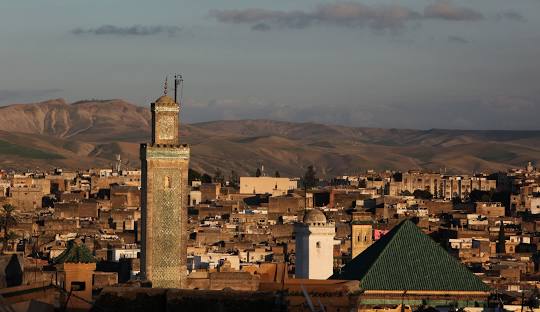Fez, Morocco
🕌 Fez, Morocco: The Timeless Labyrinth of Culture and Craft
Step Into the Soul of Morocco’s Oldest Imperial City
🗺️ Overview
Fez (or Fès), the cultural and spiritual heart of Morocco, is a city where the past breathes through narrow alleyways, colorful tiles, and echoing calls to prayer. Founded in the 9th century, Fez is home to the world’s oldest university, bustling souks, and Morocco’s most complete medieval medina—Fes el-Bali—a UNESCO World Heritage Site. Time slows down here, inviting travelers to lose themselves in one of the most atmospheric cities on Earth.
🏛️ Top Attractions
🏺 Fes el-Bali (Old Medina)
A maze of over 9,000 alleys, Fes el-Bali is a sensory overload of market stalls, spice scents, donkeys hauling goods, and artisans at work. It’s the heart and soul of the city.
🕌 Al-Qarawiyyin Mosque & University
Founded in 859 AD, this is the oldest existing, continually operating university in the world. Though non-Muslims can’t enter the mosque, you can peek in from the madrasa library side.
🐪 Chouara Tannery
Fez’s iconic leather tannery is a vivid scene of ancient tradition—workers dyeing hides in stone vats of natural pigments. Visit a leather shop for the best rooftop views (and grab a sprig of mint to mask the strong smell!).
🏰 Bab Bou Jeloud (Blue Gate)
The grand entrance to the old medina, tiled in brilliant blue and green zellige. A perfect photo spot and a bustling social hub.
🛕 Bou Inania Madrasa
This 14th-century Islamic school features some of Morocco’s finest wood carvings, stucco, and tilework—open to non-Muslim visitors.
🍽️ Local Cuisine
🍲 Bissara
A humble yet heartwarming fava bean soup, often eaten for breakfast with olive oil and bread.
🍛 Rfissa
A comforting dish of shredded bread, lentils, and chicken, drenched in spiced broth and often served during celebrations.
🍢 Brochettes
Grilled meat skewers sold at street stalls, seasoned with cumin and served with fresh flatbread.
🫖 Mint Tea ("Berber Whiskey")
Symbol of Moroccan hospitality—sweet, refreshing, and served throughout the day.
💡 Tip: For the best authentic food, dine at a riad or a local family-run eatery inside the medina.
🎭 Culture & Festivals
🕌 Sacred Music Festival (June)
An internationally acclaimed celebration of Sufi music, world chants, and spiritual rhythms held in historic venues across Fez.
🧵 Artisan Workshops
Fez is famous for zellige tile-making, leatherwork, embroidery, and brass engraving. Visit cooperatives and workshops for live demonstrations and ethically sourced souvenirs.
🛏️ Where to Stay
🏨 Luxury: Riad Fes – Relais & Châteaux
A majestic stay in a restored palace featuring intricate mosaics, courtyards, rooftop views, and fine dining.
🛎️ Mid-Range: Riad Laaroussa
Charming, central, and peaceful—with exceptional hospitality and hammam services.
🏠 Budget: Dar Elinor
Budget-friendly yet atmospheric with authentic Moroccan decor and breakfast included.
🛍️ Shopping & Souvenirs
-
👜 Handmade Leather Goods – Bags, slippers (babouches), and belts from the famous tanneries.
-
🧿 Ceramics & Pottery – Blue Fassi pottery is iconic to Fez.
-
🎨 Zellige Tiles & Brassware – Intricate mosaic tiles and engraved metal trays.
-
🧵 Djellabas & Kaftans – Traditional Moroccan garments.
🧭 Travel Tips
🌡️ Climate
Best seasons to visit are spring (March–May) and fall (September–November). Summers can reach 40°C (104°F) and winters are cool and damp.
💬 Language
Arabic and Moroccan Darija are widely spoken. French is commonly understood. A few words in Arabic (e.g., Shukran – thank you) go a long way.
💳 Currency
Local currency is the Moroccan Dirham (MAD). Cash is king in the medina; carry small bills.
📶 Connectivity
Free Wi-Fi is common in riads and cafés. SIM cards are cheap and easy to find.
🧭 Getting Around
Fez is best explored on foot, especially inside Fes el-Bali. Maps can be tricky—consider hiring a local guide for a deeper, stress-free experience.
🚖 Transport & Access
-
✈️ Airport: Fès–Saïs Airport (FEZ) is just 15 km from the city, with regular flights to Europe and Casablanca.
-
🚖 Taxis: Affordable but always agree on the fare before departure.
-
🚆 Train: Fez is connected via ONCF trains to Rabat, Marrakech, Tangier, and Casablanca.
📍 Pro Tip: Take the CTM or Supratours buses for air-conditioned comfort on intercity routes.
📸 Best Photo Spots
-
Rooftop view of Chouara Tannery
-
Sunset from Borj Nord Fort
-
Intricate tilework inside Bou Inania Madrasa
-
Arched entrance of Bab Bou Jeloud
⭐ Destination Ratings
| Category | Rating (★ out of 5) |
|---|---|
| Cultural Richness | ★★★★★ |
| Cuisine | ★★★★☆ |
| Natural Beauty | ★★★☆☆ |
| Affordability | ★★★★★ |
| Ease of Travel | ★★★★☆ |
| Safety | ★★★★☆ |


